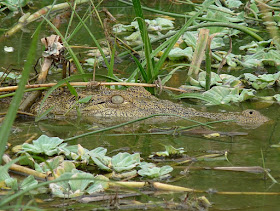This is the third of a series on this magnificent national park in far western Uganda; the series began here. The Kazinga Channel is a broad natural channel which joins the much smaller Lake George to the east, with enormous Lake Edward (230,000 hectares) to the west. Lake George is technically one of the Rift Valley Great Lakes, but at a mere 25,000 hectares does not qualify for the title! Lake Edward does, but only as the smallest of them. George is higher than Edward and water flows via it from the Rwenzori Mountains to Lake Edward. The bigger lake was for a short and less glorious time of its history known as Lake Idi Amin - it is sometimes referred to as Lake Rutanzige, which I suspect is a much more appropriate local name, but there seems little enthusiasm for its general usage. Lake Edward is divided between Uganda and the Democratic Republic of the Congo, with the Congo controlling the majority of it; its shoreline is entirely within national parks. It is believed that the channel results from volcanic activity which filled in much of a formerly vast lake, forming two smaller lakes joined by the current channel, though this may not be all of the story.
 | |
| View across the Kazinga Channel; there are some fishing settlements within the park, with people living in apparent harmony with the wildlife. |
There is a small launch which runs regular trips into the channel from its mouth at the Lake Edward end, below Mweya Lodge - you won't get anywhere near Lake George however, there is far too much to see! (Not to mention the rapids that block the way.) Indeed it was one of the most memorably wildlife-rich boat trips of my life. The concentrations of hippos and buffaloes alone are simply astonishing.
 |
| Part of a buffalo herd on a sand spit. |
 |
| Wallowing is very popular. |
 |
| Big buffalo bull - an excellent reason to do your wildlife watching from a boat. |
 |
| Mother and calf. |
Hippos and buffaloes happily coexist - there's enough mud to go around, and they're not competing for food.
 |
| Mother with apparent twins. |
The Nile Crocodile Crocodylus niloticus story in the channel is a fascinating one. Until the 1950s they weren't found at the western end of the channel - it is suggested that this was related to the volcanic event which formed the channel. Then however, people began to cut paths through the forest alongside the channel, and the crocodiles were able to use them to bypass the rapids which had hitherto thwarted them.
Not all mammals seen were associated with the water though - and I'm sure that at the right time of day many others could be seen coming to drink too.
 |
| Warthog Phacochoerus africanus - this one lived to raise its tail another day. |
The bird diversity was quite overwhelming, with waterbirds of course predominating. The populations of fish and other aquatic animals in the channel are obviously immense, based on the numbers of fish-eating birds present.
 |
| Grey Heron Ardea cinerea; this is the same species found throughout Europe and much of Asia, as well as sub-Saharan Africa where it is a breeding resident. |
 |
| The African Fish Eagle Haliaeetus vocifer is another voracious piscivore. Its species name is appropriate - its ringing yelps, often in chorus, form one of the sounds of Africa for me. |
The Fish Eagle isn't the only bird of course which is named for its fish-eating habits, and two kingfishers were common along the channel - the Pied Kingfisher Ceryle rudis is in fact abundant, as it can be throughout much of Africa and southern Asia.
 |
| This fish clearly needed a lot of tenderising! This is the only member of the genus Ceryle. |
 |
| The exquisite little Malachite Kingfisher Corythornis cristatus is another common and widespread African kingfisher. Like the Pied Kingfisher, but unlike the majority of other species, the Malachite really does eat mostly fish. For more on this apparent contradiction, see here. |
 |
| The handsome Yellow-billed Stork Mycteria ibis wades for its fish, like the herons. |
Like the Spur-winged Lapwing Vanellus spinosus accompanying the stork above, other waterbirds present do not rely on fish.
 |
| The Hadada Ibis Bostrychia hagedash - the common and scientific names are intended to reflect its remarkable and familiar call across sub-Saharan Africa - favours earthworms and snails. |
 |
| The African Black Crake Amaurornis flavirostra is common and widespread, and unlike many other crakes is not particularly secretive. Nonetheless I've never had better views than at Kazinga. |
And finally, a bird not directly associated with the water at all.
If you go to Queen Elizabeth National Park, you'll of course do this boat trip, but I'd suggest that if you're wavering as to whether to include it in your Uganda trip, Kazinga Channel should just about swing it for you.
BACK ON THURSDAY















All of your African posts cause me to recall our time in Tanzania. Well done. This post brings to mind a trip to Selous Game Reserve which included a trip to a small shallow lake on a cloudy day, This meant the hippos were out of the water and charged the boat across the shallows. We stayed in the deep bits.
ReplyDeleteYour readers might be interested in Stone Curlew etymology.
Thanks Martin, glad they give you some pleasure. Thanks too for the stone curlew link - I'd like to be able to link to my own book, but sadly can't...
ReplyDelete